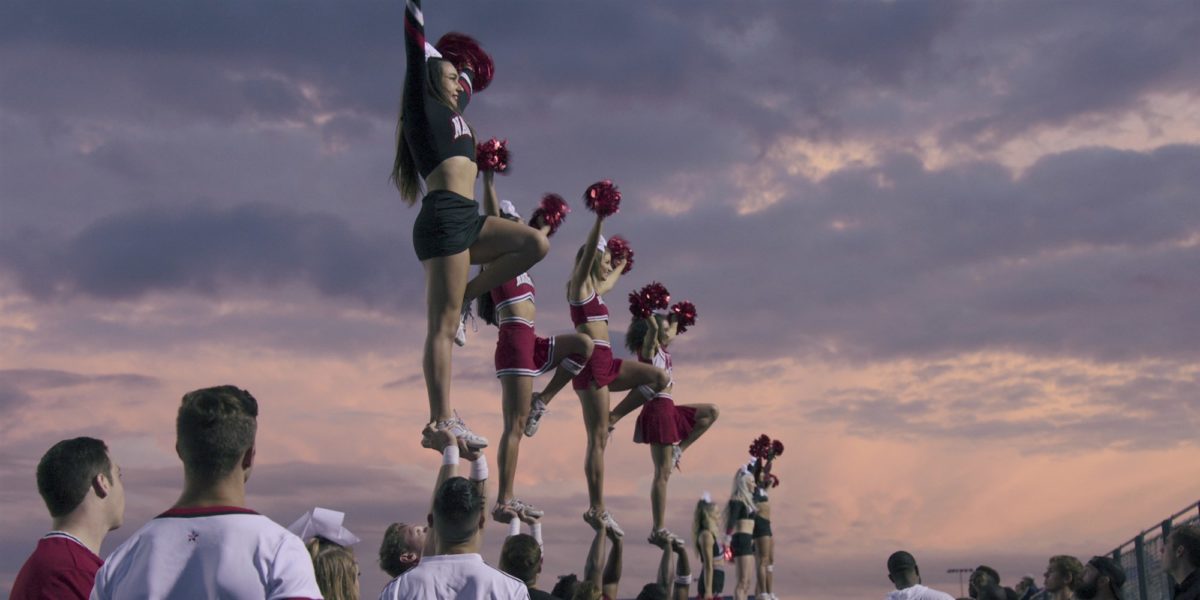As the final scenes roll through Cheer, the six-part Netflix documentary on the many-times-over-championship cheerleading squad at Navarro Junior College, the camera closes in on the squad’s official coach and unofficial mother Monica Aldama. Aldama is back where our series began, sitting in a nondescript college gym, watching young women cheer and tumble, taking notes with a pen. She tells another coach, “You’re looking for potential.” The song “Snowqueen of Texas,” the suggestion as subtle as a sledgehammer, plays right before the credits roll.
If you’ve ever read or watched anything about sports, the contours of Cheer will feel old and familiar, like a book you’ve read before but always enjoy revisiting. Series director Greg Whiteley also helmed Netflix’s Last Chance U, so he knows what viewers expect and how to deliver it. There’s the small-town setting, in this case Corsicana, Texas, population about 23,000. There’s the athletes with traumatic childhoods, saved by their sport. There’s the steely coach, Aldama, who gives them the love and discipline they need, as well as lieutenants enforcing her vision. There are athletes trying to keep up their grades while school practices and competition, for which they are not paid, consume their lives. There’s even a sprinkling of what Jesus would do. The entire series builds to a big prize on the line, countless things going wrong, and a last-minute near catastrophe.
And, this being about athletes, there are a lot of injuries, including concussions.
Within the first 20 seconds, you hear “ouch” from cheerleader Morgan Simianer. Cheerleader Lexi Brumback tells us: “There are sometimes I’ll accidentally land wrong and it’s just, it’s terrible pain. But it’s worth it. I mean, I was saved by cheer.” Before the title card appears, a voice tells viewers, “You’ve got to be checked in. That’s how you get hurt, that’s how things mess up.” From there, the injuries pile up.
Before the first episode ends, two cheerleaders are evaluated for concussions. At least one is shown on camera being told to stay in a dark room, not look at her phone, and sit out the rest of the day—common advice after a suspected concussion—but later viewers see her still at practice, although not participating. Then another cheerleader falls. Someone says “We’re knocking ’em out left and right.” Athletic trainer Cameron Hieb tells another trainer, “Monica’s gonna love me when I hold out three of her girls.”
In episode two, cheerleader Allie Ross says “this is my fifth concussion” and then explains it away as “nothing really new for me, but in the grand scheme of things it’s cheerleading and that’s usually what happens to get it perfect.” Aldama later refers to cheerleaders who are medically held out of competition as “these two girls that can’t do anything.”
Cheer doesn’t hide the sports brutality; it shows the taped-up body parts, the bruises, the wincing, and the cheerleaders ignoring any advice from doctors that involves not cheering. Author Natalie Adams appears and speaks about the sport’s high number of catastrophic injuries. If anything, the show seems to offer the constant agony as a sort of evidence for the sport’s leigtimacy: These must be real athletes if they get hurt this often and play through this much pain. This is not a new argument. I heard similar from cheerleaders at my own high school in the late 1990s.
What policies Navarro might—or should—have in place to make cheerleaders safer aren’t heavily addressed. Oversight of the sport largely is handled by the Bain Capital Private Equity-owned Varsity Brands. Matt Stoller wrote an excellent wrap-up of how Varsity became the Standard Oil of cheerleading, but the shortest way to illustrate the direness of the situation is knowing that regulation by the NCAA, a cartel created as a tool of wage suppression, is viewed as a possible solution. (College cheerleading is “not a sport for which the NCAA provides or enforces rules,” according to the NCAA’s own documents.)
But that ignores one other possible layer of accountability — the National Junior College Athletics Association, which includes Navarro. The most recent NJCAA handbook online recommends that each member school “develops and implements a concussion management plan for all student-athletes.” It also outlines a concussion testing protocol.
Knowing they had to have something, I submitted a public records request for Navarro’s concussion protocol, concussion policy, and rules or policies regarding athlete safety that applied to the cheer team. The school replied with three documents: Their concussion assessment plan, their return-to-play rules for concussions, and their traumatic head injury policy.
Here’s how Navarro’s concussion assessment plan works, according to the document. Each athlete is supposed to do “baseline neurocognitive testing” before they start. They use the “IMPACT concussion management system” for that. An athlete suspected of having a concussion “should be removed immediately from competition for evaluation” and they may not return until to play until they are cleared. Here is the rest of how testing is described:

These are the return-to-play guidelines for an athlete.

The full policy is embedded below.
Next is the return-to-play protocol. It offers five steps for athletes returning from a concussion: aerobic conditioning, then sport-specific exercise, then returning to the sport without contact, followed by full contact, and finally full clearance. If each step can be done “with no return of symptoms during exercise or within 24 hours,” then the athlete can move on to the next step. The policy is embedded below:
The final document provided is the traumatic head injury policy. It says that paramedics should be contacted if a traumatic head injury “renders an athlete unconscious.” One exception is allowed: “[I]f the Certified Athletic Trainer and/or Team Physician witness the mechanism of injury and determine it is not medically emergent or necessary to transport the athlete to the hospital.” It adds that any loss of consciousness means an athlete should “be removed immediately from competition and treated accordingly via the Navarro College Concussion Assessment and Management Plan.” The rest of this document is embedded below.
Did we see these policies enforced in Cheer? The truth is, I can’t be sure. I watched all six episodes in a row and took notes on discussions about concussions, athlete safety, and injuries. The documentary shows you horrifying falls, lets you hear the thuds and the screams. A few times I saw what were glimpses of what are presented as concussion testing: standing on one leg, closing your eyes and touching your nose with each hand. But the focus after any fall, concussion or not, wasn’t on testing. It’s on the mandatory punishment: a drop means everyone has to do 50 push-ups. Cheer treats concussions much the same way a football or hockey broadcast treats them: an event happening on the sidelines, nothing worth paying that much attention.
(In an interview with E! News, Aldama said the show cut out “all the precautions we take for safety, the progressions that we do, the times that the kids are sitting out, or they’re getting treatment.” She brings up Alabama quarterback Tua Tagovailoa playing after an ankle injury, saying when you’re an elite athlete “you push your body to limits that just your average person doesn’t do.)
As in other sports with regular head trauma, Cheer reaches the ugly nadir of athletes’ brain injuries—the pressure to please their coach is all-consuming. Athletes in other sports have found ways to fake their way through concussion tests and get back on the field. Why would Navarro cheerleaders be any different?
The point of Cheer, the glory of Cheer, is how persuasively it makes the case for treating cheerleading as seriously as any other sport. Cheerleaders! They’re athletes too! And they are true American athletes, with the rampant exploitation, and broken bodies and brains to prove it.




V97.33XA says:
Excellent stuff. Proud to see sports-based journalism back from my favorite crew!!
February 2, 2020 — 1:22 pm
Sheri says:
didn’t even think of this excellent take. Thanks, Diana!
February 2, 2020 — 1:25 pm
The Curse of Harold Ballad’s Bunker says:
Long time reader, first time commenting.
My son played select level hockey here in Canada and at the time I thought that culture was singular in it’s excessiveness. Then I found out about figure skating, dance teams and finally cheerleading. I’ve now come to realize that all organized youth sports and related activities have become scaled down versions of professional sports. Right down to the lack of concern over the long term impact of injuries. It doesn’t have to be that way. It’s a pastime, not a job.
Thanks, I’ll hang up now and listen.
February 2, 2020 — 1:33 pm
Gardner minshew is my spirit animal says:
It’s scary how they are the same.
February 2, 2020 — 7:09 pm
Bunny says:
As a middle aged woman who has been living with the after effects of 11 concussions since my younger days, this is simply horrifying, I can already see a potential follow up documentary in 20 years, where these same former cheerleaders will be discussing how their repeated concussions have severely impacted their lives—cognitive changes, memory loss, frequent headaches, anger episodes. I’m hoping not, but it’s a statistical probability, as are the chances that one of these kids will end up taking their life because of post concussion changes in the brain.
Diana, as always, this is terrific reporting! I’ve been so happy to see you and the other writers here this weekend, and hope there is some way to make this a permanent place to read your work. Thank you, Dashlane!
February 2, 2020 — 1:36 pm
Diana Moskovitz says:
Thank you for sharing your story here with all of us! And if you ever want to talk with a reporter about it, you can find me at dfmoskovitz@gmail.com. (You also can totally ignore that part, it just feels like I’m not doing my job if I don’t give that option.)
February 2, 2020 — 5:21 pm
dcat says:
Oh sure, but when I request “pubic records” from the cheerleading team I get brought up on Title IX charges. Hypocrites, the lot of ya.
February 2, 2020 — 2:00 pm
King Ginger says:
+1
February 2, 2020 — 2:41 pm
LemmyKilmister says:
Sometime in 1979 or ’80 I attended a UNC basketball game, and the cheerleaders did that thing where they throw a girl high into the air and catch her, only they forgot that last part. She was out cold for a good few minutes.
February 2, 2020 — 2:02 pm
Darwin says:
That’s like a famous story with video somewhere.
February 3, 2020 — 1:53 pm
Aericks says:
Is anyone studying traumatic brain injury in female athletes? I wonder how repeated concussions manifest. Is it the same as for men or different? Women often receive sub-par treatment from the medical community. I wonder if symptoms of TBI get dismissed or ignored routinely.
February 2, 2020 — 2:03 pm
Bunny says:
I posted upthread that I’ve suffered numerous concussions. (It’s actually 13, not 11 as I previously mentioned). I don’t know of any studies, but I can tell you that my life has been severely impacted, and my initial symptoms were frequently dismissed or misattributed, just as you’ve guessed. Here are the issues I’m now stuck with: chronic intractable migraines, issues with memory, loss of executive functioning abilities, depression and anxiety that medication doesn’t help, insomnia, etc.
February 2, 2020 — 4:36 pm
Darwin says:
Yes there are tons of studies. As a HS Athletic Director, I read countless studies of how girls soccer and cheer produce more concussions than any other sport.
February 3, 2020 — 1:55 pm
19thBurnerBreakdown says:
A lot of my concern on this front is that the women doing this are already somewhat marginalized (that’s part of the “cheer saved me” traumatic backstory that sells the show) and when some of them fall into addiction, depression, inability to hold jobs, etc. it will just be written off by those around as “reverting to type” and not linked to the serious medical conditions.
February 3, 2020 — 1:56 pm
Bald headed scallywag says:
I just want everyone to know that there are only TWO junior college teams competing for the national championship in cheerleading. Navarro has a 50 % chance of winning a natty EVERY YEAR.
February 2, 2020 — 2:41 pm
Alanna says:
In their defense, though, they also won the Grand National for something like five years in a row. That’s the “Best in Class” trophy, meaning they had the best score of ALL the colleges, including the D1A universities like Louisville and Texas Tech.
February 3, 2020 — 3:07 pm
Anothervoiceinthecrowd says:
Where can I deposit my Freedom Dollars to keep this going? What a weekend.
February 2, 2020 — 3:49 pm
Paul T says:
The Matt Stoller story linked in the article is a must read. A sport that is monopolized by a clothing brand!
Also, in your list of “familiar things to overcome” you forgot the “dead grandmother inspiration with background tinkly music.
February 2, 2020 — 4:13 pm
Sonnet says:
The less regulation and oversight there is for kids’ sports, the more concussions everyone will get, which means everyone will be stupider, which means you have an easily-controlled populace who’s bankrupted by horrible pain and medical bills 🙃
February 2, 2020 — 8:18 pm
UTSB: a new hope says:
I am so glad to see Diana’s name in print, I think I need to stay in a dark room, not look at [my] phone, and sit out the rest of the day.
February 2, 2020 — 8:41 pm
Mustbejelly says:
I have hated how the press has treated Aldama, like a white savior of these wayward youth. In reality throughout Cheer she is shown to be absolutely heartless. Really appreciate this take, since all the other media has treated these injuries and these crazy expectations as if its something to be celebrated and honored.
February 2, 2020 — 9:27 pm
lane says:
I was mortified by that aspect of the documentary and press coverage. That woman absolutely abuses her power over those kids to get to her wins.
February 3, 2020 — 11:58 am
Pedantic Comment says:
Holy shit you’ve been missed. Goddammit, you ask the right questions.
Also, FIFTH CONCUSSION?
Also also, Bain Capital — isn’t that Romney’s deal?
February 3, 2020 — 12:45 am
Paul M. Lundgren says:
We’ve missed you, Diana. Best of luck, and keep up more of this–it’s outstanding.
February 3, 2020 — 9:47 am
Darwin says:
I watched Cheer and thought the same thing about the concussions. But then I realize that this documentary was from the same people who did Last Chance U and I realize it probably had a lot of overdramatization.
What Really caught me off guard is the fact that they’re literally only two teams in junior college that do competitive coed cheerleading. So, their national championship is just beating the other school. When they don’t win a national championship, they lose to the other school. That took a lot of the drama out of this documentary.
February 3, 2020 — 1:51 pm
19thBurnerBreakdown says:
I worked as a student athletic trainer when I was in undergrad, doing first aid and amateur sports medicine to get the hours needed for PT school and burnish the resume. That some kid with a CPR certification and a couple hours of learning taping was sometimes the only medical provider around scares me now that I think back on it.
It also meant that whenever 18 year old me felt someone was too injured to return, I had to fight the coach that wanted the player back and the player who wanted to come back. I never won.
February 3, 2020 — 2:00 pm